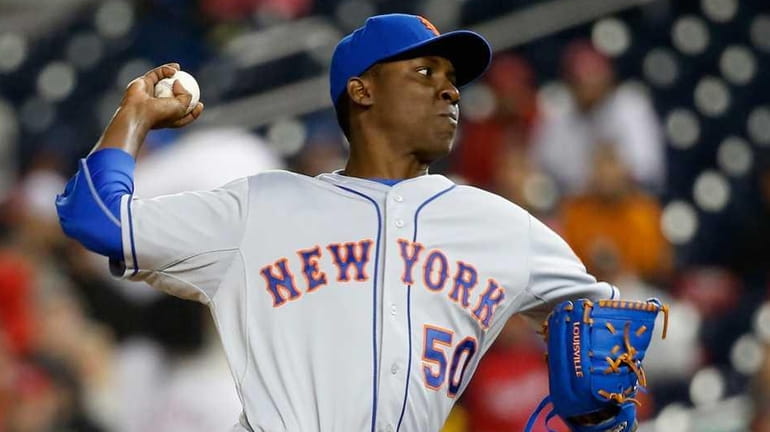Mets reliever Rafael Montero breaking old habit of tipping pitches

Pitcher Rafael Montero of the New York Mets throws to a Washington Nationals batter in the eighth inning of the Nationals win at Nationals Park on April 8, 2015 in Washington. Credit: Getty Images / Rob Carr
From the Mets' dugout, it was like watching the world's worst poker player walk into another ambush. Rafael Montero couldn't help himself.
Veteran confidants Bartolo Colon and Bobby Abreu took Montero under their wing. In the video room late last season, they picked apart his mannerisms. Still, the pitching prospect could not kick his old habits.
If Montero's teammates knew what was coming, so did his adversaries in the batter's box.
"He couldn't have telegraphed it even more," said pitching coach Dan Warthen, who believes that Montero finally has found a solution. "It was that obvious before, with every pitch."
An injury has created a void for Montero to fill. With Jenrry Mejia on the disabled list with a balky elbow, manager Terry Collins has reshuffled his bullpen.
Jeurys Familia will take on closing duties with an occasional assist from lefty specialist Jerry Blevins. Carlos Torres will move into a setup role, leaving the 24-year-old Montero as the primary option in the seventh.
Though Montero is a starter by trade, the Mets believe he can handle the transition. In 10 appearances in the course of two call-ups, he went 1-3 with a 4.06 ERA in 441/3 innings last season. Now they hope his previous exposure to the big leagues will help.
"Last year was a little bit of [wildness], not throwing enough strikes," Montero said through a translator.
But the most lasting lesson from his first taste of the big leagues had more to do with the mannerisms than anything else. He had betrayed his own plans.
When Montero set up to throw his changeup, he tilted his glove to the right. With his fastball, he held it at an angle. With his curveball, he pointed it toward the sky.
Triple-A hitters didn't notice. The Nationals did. During an Aug. 12 start, they torched Montero for five runs and seven hits in five innings.
"It was so blatant, we were calling out every pitch," said Warthen, who watched from the dugout and winced.
The work to correct the problem began in earnest. It didn't take at first. Still, 18-year veteran Colon became a resource. As did Abreu, another 18-year vet who developed a reputation as one of the game's most cerebral hitters.
Bullpen coach Ricky Bones said the most useful advice often comes from hitters because they spend their time breaking down tendencies.
Bones learned from experience. He already had spent three years in the big leagues and was about to become an All-Star when his own teammates let him in on a secret. Whenever he threw a breaking pitch, Bones took a deep breath and puffed out his cheeks like a chipmunk.
"Sometimes you get into bad habits and you get away with it in the minor leagues," Bones said. "But once you come to the big leagues, every hitter is a good hitter and every at-bat is recorded and on TV."
Through the years, Warthen has seen plenty of "deep breathers" such as Bones. More commonly, pitchers change their glove position, moving it higher for fastballs or lower for breaking balls. Or they vary the speed of their deliveries based on the pitch, as was the case with former Mets righty Mike Pelfrey.
For Montero, the culprit proved to be glove placement and delivery tempo. Both have been addressed.
On Wednesday against those same pesky Nationals, Montero logged two scoreless innings in relief, allowing one hit.
Before every pitch, his hands came set at a fixed point. And regardless of his offering, his delivery moved at the same speed. He no longer was revealing his cards.
Said Warthen, "It just takes time."
